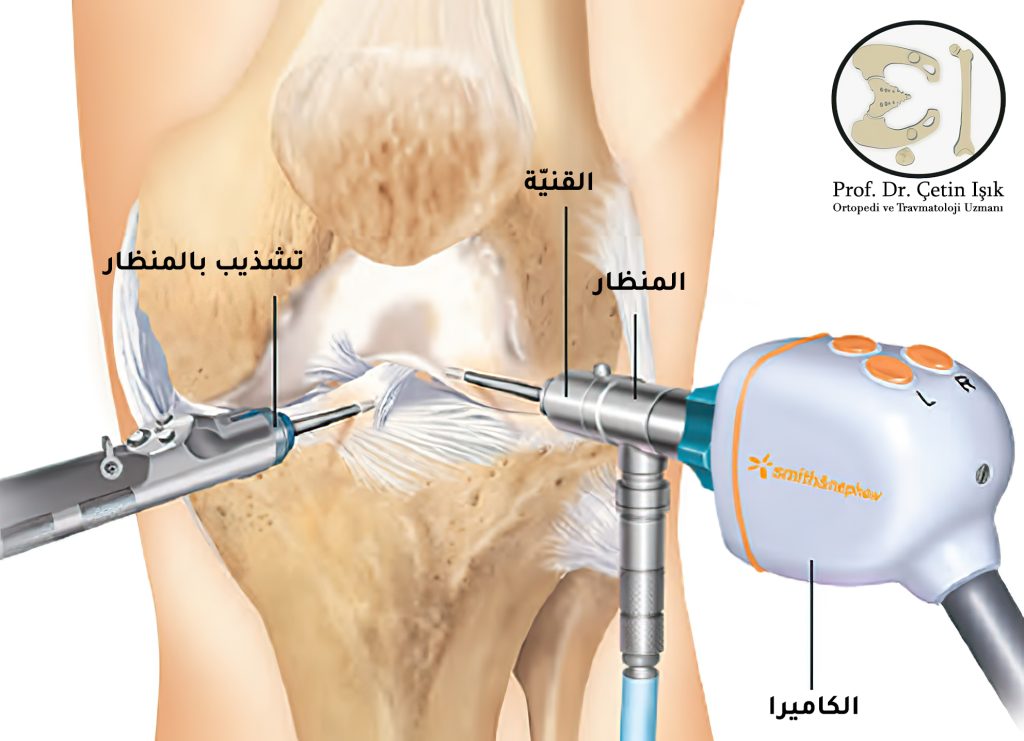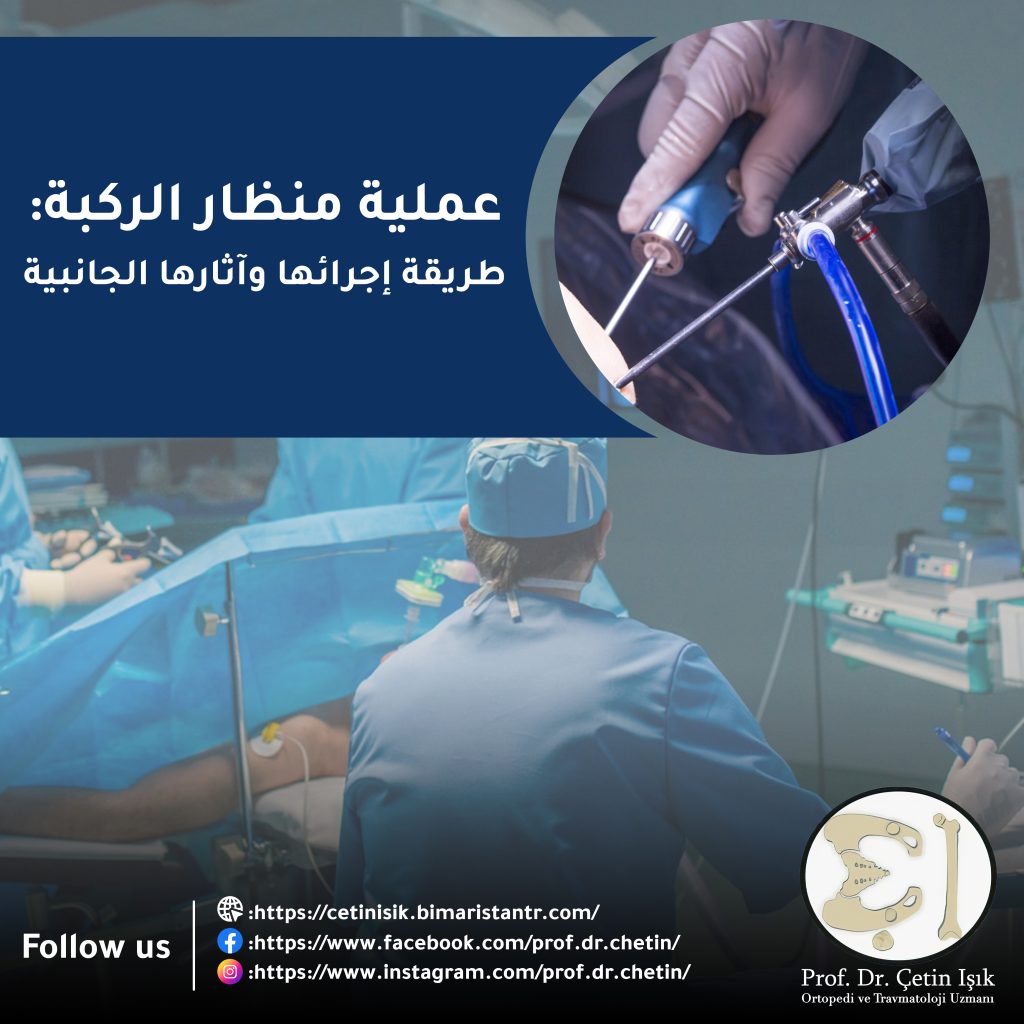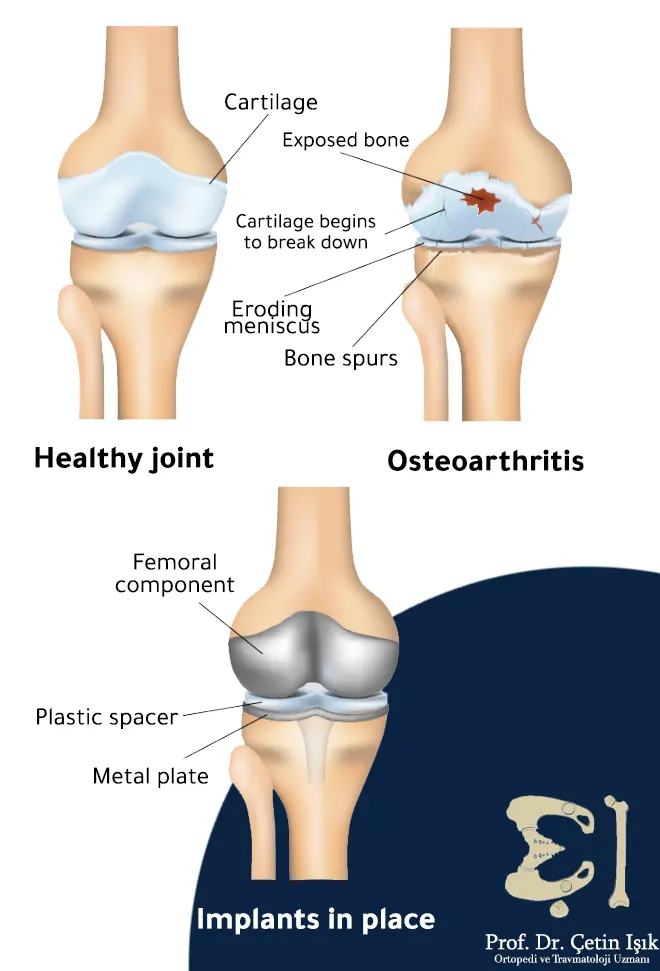ما هي عملية منظار الركبة؟
عملية Knee arthroscopy (Knee Arthroscopy) هي إجراء جراحي بسيط يتم من خلاله إدخال كاميرا صغيرة (المنظار) عبر شقوق صغيرة في الجلد لمعاينة مفصل الركبة من الداخل، وتشخيص أو علاج مشكلات مثل تمزق الغضروف أو الأربطة، إزالة الأجسام الحرة، أو إصلاح الأنسجة التالفة.

تُعد هذه العملية من أكثر الإجراءات شيوعًا في مجال جراحة العظام، وتمتاز بأنها طفيفة التوغل، ما يعني ألمًا أقل، ومضاعفات أقل، وشفاء أسرع.
الحالات التي تعالجها عملية منظار الركبة
| الحالة | الشرح |
|---|---|
| Meniscus rupture | إزالة الجزء التالف أو إصلاحه باستخدام أدوات دقيقة |
| إصابة الرباط الصليبي الأمامي أو الخلفي | فحص وإعادة بناء الأربطة حسب شدة التمزق |
| التهاب الغشاء الزليلي | إزالة الأنسجة الملتهبة المسببة للألم |
| الأجسام الحرة داخل المفصل | إزالة قطع الغضاريف أو العظام الصغيرة التي تعيق الحركة |
| تنضير الركبة | تنظيف المفصل من الأنسجة المتليفة وتخفيف الألم الناتج عن الخشونة |

مراحل عملية منظار الركبة في إسطنبول
- التقييم السريري والتصوير
يتم فحص الركبة سريريًا مع إجراء تصوير بالرنين المغناطيسي (MRI) لتحديد المشكلة بدقة. - Anesthesia
تُجرى العملية عادة تحت تخدير نصفي أو كلي حسب الحالة. - إجراء العملية
يتم عمل شقوق صغيرة في الجلد لإدخال المنظار والأدوات الجراحية، ثم إجراء الإصلاح المطلوب داخل المفصل. - الخروج من المستشفى
يخرج المريض في نفس اليوم أو في اليوم التالي غالبًا. - برنامج التأهيل والعلاج الطبيعي
يُنصح بجلسات علاج طبيعي لتسريع التعافي وتحسين حركة المفصل.

مزايا إجراء منظار الركبة في إسطنبول
- أطباء بخبرة دولية في جراحة المفاصل.
- أحدث تقنيات المنظار الجراحي بتجهيزات عالمية.
- تكلفة معقولة جدًا مقارنة بالدول الأوروبية والخليجية.
- سرعة في المواعيد والإجراءات دون تأخير.
- دعم شامل للمرضى الدوليين يشمل الترجمة، التنقل، والإقامة.
تكلفة عملية منظار الركبة في إسطنبول
| البند | التكلفة التقريبية بالدولار الأمريكي |
|---|---|
| الفحص والاستشارة الأولية | 100 – 200 |
| تصوير بالرنين المغناطيسي (MRI) | 200 – 400 |
| العملية تحت التخدير النصفي أو الكلي | 2,500 – 4,500 |
| الإقامة في المستشفى (ليلة واحدة) | 100 – 300 |
| العلاج الطبيعي (5 – 10 جلسات) | 400 – 800 |
تختلف التكلفة حسب درجة تعقيد الحالة والمستشفى وخبرة الجراح.
مقارنة الأسعار عالميًا
| الدولة | تكلفة منظار الركبة (متوسط) |
|---|---|
| إسطنبول – تركيا | 2,500 – 4,500 USD |
| ألمانيا | 6,000 – 10,000 USD |
| الولايات المتحدة | 8,000 – 15,000 USD |
| الإمارات | 5,000 – 9,000 USD |
فترة النقاهة والتعافي
| المرحلة | المدة المتوقعة |
|---|---|
| المشي بدون عكازات | خلال 1 – 3 أيام |
| العودة إلى العمل المكتبي | 5 – 10 أيام |
| العودة للأنشطة اليومية | خلال أسبوعين |
| العودة للرياضة أو الجهد العالي | بعد 4 – 6 أسابيع (حسب الحالة) |

من هم المرشحون لعملية منظار الركبة؟
- الأشخاص الذين يعانون من ألم مستمر في الركبة غير مستجيب للعلاج الدوائي.
- Patients تمزق الغضروف الهلالي أو الرباط الصليبي.
- من يعانون من تورم متكرر أو حركة محدودة في المفصل.
- الرياضيون المصابون بإصابات مفصلية مزمنة.
أسئلة شائعة حول منظار الركبة في إسطنبول
Is knee arthroscopy painful?
لا، حيث تُجرى تحت التخدير، ويشعر المريض بانزعاج بسيط بعد العملية يزول خلال أيام.
هل هناك مضاعفات للعملية؟
نادرًا، وتشمل العدوى أو التورم، ويتم التحكم بها بسهولة في المراكز المتقدمة.
هل أحتاج للبقاء في إسطنبول طويلاً؟
يفضل البقاء 5 – 7 أيام بعد العملية لمتابعة أولية وجلسات العلاج الطبيعي.
هل يمكنني السفر وحدي؟
نعم، ولكن يُفضل وجود مرافق خلال اليومين الأولين بعد العملية.
الخلاصة
إذا كنت تبحث عن علاج فعال ومريح لمشكلات الركبة المزمنة أو الإصابات الرياضية، فإن عملية منظار الركبة في إسطنبول تعد خيارًا ممتازًا يجمع بين الكفاءة الطبية العالية، والتكنولوجيا المتطورة، والتكلفة المناسبة. سواء كنت مريضًا محليًا أو من خارج تركيا، ستجد في إسطنبول الرعاية التي تستحقها في بيئة آمنة ومهنية.
Common questions
The patient needs several days to a week of rest after knee arthroscopy, with the necessity of raising the leg and placing ice packs during this period in order to reduce pain and swelling.
Knee arthroscopic surgery reduces damage to the structures around the joint, in addition to being a less invasive and painful surgery and the recovery time is shorter than open surgery.
Most knee arthroscopic procedures usually take less than an hour (30-50 minutes).
You can walk immediately after the operation, but you must do the exercises prescribed by the doctor for 20-30 minutes 2-3 times a day to fully restore the strength and ability of the knee.
You should refrain from drinking alcohol and operating machinery after knee arthroscopy.
Knee arthroscopy is done by making a small incision and inserting an endoscope inside the knee to view the knee joint from the inside. Other incisions may be made to insert other tools in cases of surgical treatment.
Usually the wound heals after arthroscopic surgery within two weeks.
The cost of a knee arthroscopy starts from $3,000.
The patient does not feel pain during the operation due to anesthesia, but after the operation he may feel mild pain.
Knee arthroscopy is a safe surgery and complications are very rare.




